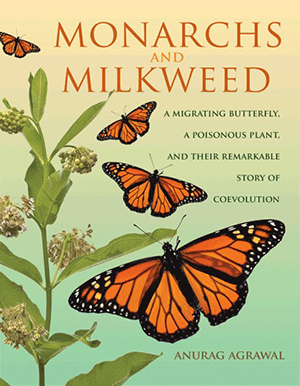Anurag Agrawal, Milkweed, and the Decline of Monarch Butterflies
By: Emily
Posted on:03/15/2018 Updated:06/12/2018When we think of wild animals losing their habitats, we don’t usually envision butterflies. Instead we might think of elephants, rhinos, and tigers in faraway places. But monarch butterflies are losing their homes right here in the US. One man who has made real strides in the research of monarch butterflies and their habitat is Anurag Agrawal. In 2017 he wrote the book Monarchs and Milkweed - A Migrating Butterfly, a Poisonous Plant, and Their Remarkable Story of Coevolution

Every summer we’ve become accustom to seeing the beautiful orange and black wings of the monarch butterfly in our yards and gardens. So when we think of wild animals losing their habitats, we don’t usually envision butterflies. Instead we might think of elephants, rhinos, and tigers in faraway places. But monarch butterflies are losing their homes right here in the US.
Migrating monarch butterfly populations are continuing to decline. In Mexican forests, monarchs inhabited only 6.12 acres in December 2017, a 15% decline over the last year and an 86% drop since 1996. Many factors have contributed to the decline in monarchs, including climate change, the deforestation of habitat in Mexico, and the loss of native plants in the US that monarchs rely on to feed and reproduce.
One man who has made real strides in the research of monarch butterflies and their habitat is Anurag Agrawal. In 2017 he wrote the book Monarchs and Milkweed - A Migrating Butterfly, a Poisonous Plant, and Their Remarkable Story of Coevolution. In his book, Agrawal dives into major scientific discoveries, including his own original research, and traces how plant poisons have not only shaped monarch-milkweed interactions but have also been culturally important for centuries.
A self-proclaimed biophiliac, Agrawal was born in Allentown, Pennsylvania and currently serves as Professor of Ecology and Evolutionary Sciences and Faculty Fellow at the Atkinson School of a Sustainable Future at Cornell University. Agrawal attributes his initial interest in insects and plants to his mother’s love of gardening. When asked what made him so interested in monarch butterflies specifically he said;

“It was a bit of an accident, mostly that they are common (some would say weedy) yet native species to North America. Perhaps more generously, with the help of others, I realized that they are extreme examples of highly specialized organisms. Monarchs only eat milkweed, they are highly toxic, and they undertake one of the most extreme annual migrations of any animal!”
Extreme migration is right! The monarch spends its winter months in Mexico and will travel about 3000 miles to get there. This great migration usually starts in October of each year, but can start earlier if the weather turns cold sooner than that. Agrawal agrees that this migration is not only fragile, buts it’s declining. Some research suggests that the lack of milkweed, monach butterflies main source of food, is to blame. Agrawal advocates that the focus on milkweed in monarch butterfly restoration might be misplaced. He believes solutions that address habitat fragmentation and increasing the availability of late season nectar plants should receive more consideration.
Studies have shown that the growing demand for avocados and the expansion of avocado farming in Mexico is also contributing to the decline in monarch butterflies. A university study found in the last 40 years approximately 35% of forest land in Mexico has been replaced with avocado orchards. That comes out to 111,000 acres across the state—nearly the same size as the protected forest where the monarch butterflies live. When asked his thoughts on how avocado farming has affected monarch butterflies, Agrawal said;
“This is a complex and interesting issue. Around the monarch reserve there is a lot of avocado farming. People need to eat: both the farmers who sell avocados and the market that buys them. Current varieties of avocados don’t grow as high in elevation as the monarch overwintering colonies, and so for now there is not a lot of new land conversion for this farming. Yes, farming imposes pressure on conservation, but resolving this conflict is difficult.”
So what’s the answer to restoring monarch butterflies and their habitats? There may not be just one easy solution. More attention is being brought to the decline of monarch butterflies thanks to people like Agrawal. In the United States, there is a massive effort to provide habitats for monarch butterflies, imperiled bumble bees and other pollinators. But there is no one group or agency that is currently dedicated to supporting monarch conservation, so it needs to be a group effort. All organizations, agencies and individuals must work together to improve, restore and create grassland habitats to save monarchs. As individuals, we can help monarch butterflies by reducing the use of pesticides, and leaving a few weeds in the garden. Having weeds around actually allows for biodiversity, which is likely to protect the animals that visit those plants.
 Sign In
Sign In
 Sign In
Sign In
